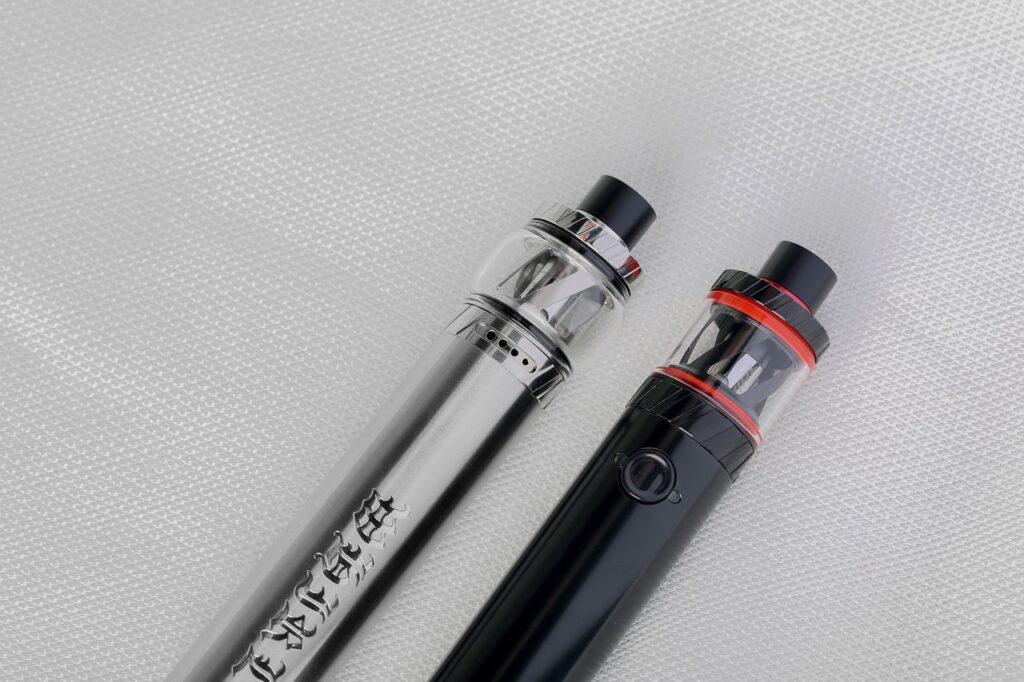Vaping is a rising public health issue due to the uncertain long-term effects of electronic cigarette use and other vaping products. Dive into these vaping statistics to understand the impact of e cigarettes and vape products on young people, young adults, and individuals across different age groups.
What is Vaping?
Smoking electronic cigarettes, also known as e cigarettes, vape pens, puff bars, and mods, falls under the term vaping. Vaping employs electronic nicotine delivery systems for nicotine and other substances, which come in both disposable and refillable formats. This encompasses vape pens, vaping devices, and other delivery mechanisms.
These electronic cigarettes produce an e cigarette aerosol that emulates traditional cigarette smoke. The aerosol is a combination of propylene glycol, glycerin, nicotine, and flavorings. The product is inhaled and exhaled in a manner reminiscent of cigarette smoking.
Emerging tobacco products, particularly e cigarettes and vape products, have been promoted as a smoking cessation tool for millions of American cigarette users. Yet, nicotine addiction, stemming from regular cigarette and tobacco use, makes the cessation journey challenging, especially because many of these vaping devices aren’t free of nicotine.
General Vaping Statistics
Many companies and organizations have promoted electronic cigarettes and vaping products as being less hazardous than traditional cigarettes. However, e cigarette use can still result in various public health issues.
Dive into these vaping facts and statistics:
- Young people and young adults, especially those under 50, are more inclined to use e cigarettes. (Gallup)
- Youth e cigarette use and vaping among young adults is a significant public health concern. (CDC)
- A number of electronic cigarettes and vape devices are compact and resemble items like flash drives, making them easy for a young person to conceal. (The New England Journal of Medicine)
- The U.S. Food and Drug Administration has not approved any e cigarette or vaping product as a guaranteed safe or effective method for smoking cessation. (National Academies of Science, Engineering and Medicine)
- Vaping devices are often used as the delivery systems for other drugs, including cannabis. (CDC)
- More than 7,700 vaping flavors are available in the market. (TobaccoFreeKids.org)
- The nicotine content in most vaping products can range from 0.5% to 5%. Yet, there’s a lack of consensus on how nicotine strength is labeled on vape products or reported in studies. (National Library of Medicine)
- 70% of employees agree that vaping in the workplace poses health risks. (EX Program)

Vaping Use Statistics
E cigarette use is on the rise, but who are the young people driving this increase in electronic cigarette popularity?
The following vaping statistics shed light on the patterns of vaping product use and the motivations behind them:
- Young adults without a formal college education engage in vaping more often than their counterparts who have had some college education. (Gallup)
- High school students have a higher tendency towards e cigarette use compared to middle school students. (FDA)
- Between July 2021 and June 2022, close to 800,000 young people tried vaping for the first time. (Truth Initiative)
- 27.6% of high school e cigarette users indicated that they use vape products on a daily basis. (Truth Initiative)
- More than 10% of teens believe that using vaping products enhances their image, making them appear “cool”. (National Institute on Drug Abuse)
- 82.9% of teen and young adult e cigarette users opt for flavored vaping products. (Tobacco Free Kids)
- JUUL holds a dominating 72% share in the electronic cigarette market, making it the preferred vaping device for many. (Tobacco Control)
- Puff Bar is the top disposable vaping device in terms of popularity. (WSJ The Journal)
United States Vaping Statistics
The Centers for Disease Control and Prevention, as well as the National Institute on Drug Abuse acknowledge the risks associated with vaping. However, organizations like the American Vaping Association believe e cigarettes can serve as a tool to reduce traditional smoking.
These U.S. vaping figures highlight the diverse perspectives within the country:
- E cigarettes were introduced to the U.S. market in 2006. (CASAA)
- 8% of U.S. residents say they have vaped recently. (Gallup)
- The prevalence of traditional smoking and e cigarette use among American adults is strikingly similar. (Gallup)
- More than half of U.S. e cigarette users are under the age of 35. (Annals of Internal Medicine)
- The majority of U.S. states and territories tax nicotine products. (CDC)
- In 2012, Kansas became the first state to implement a law necessitating licenses for e cigarette retailers. (Public Health Law Center)
- 32 states and territories in the U.S. have set guidelines related to e cigarette and vape product packaging. (Public Health Law Center)
- There was a staggering 400% surge in e cigarette usage among U.S. teens from 2019 to 2020. (FDA)
- Switching to daily vaping led 28% of Americans to quit traditional smoking products. (Medical Xpress)
Vaping Worldwide Statistics
Global regulations for e cigarettes and vaping products are vastly different, spanning from taxes and product packaging to marketing constraints.
Here’s a deeper dive into the global landscape of vaping regulations and usage:
- An estimated 35 million people engage in vaping or e cigarette use globally. (eClinicalMedicine)
- In 2008, Turkey instituted a ban on e cigarettes, forcing citizens to acquire these products exclusively through online platforms. (CASAA)
- E cigarette advertising is restricted in 78 global territories and nations. (Institute for Global Tobacco Control)
- Public vaping and e cigarette usage are entirely prohibited in 13 territories and nations. (Institute for Global Tobacco Control)
- The sale of nicotine-infused e cigarettes is barred in countries that include Jamaica, Japan, and Switzerland. (Institute for Global Tobacco Control)
- E cigarette and vaping product packaging within the European Union mandate including ingredient lists and health-related cautions. (European Commission)
- The United Kingdom believes that vaping and e cigarettes are a less harmful alternative to traditional tobacco smoking. (Gov.UK)

Teen Vaping Statistics
With a number of vaping flavors, cost-effective options, and discreet vaping device designs, it’s no surprise that young people are drawn to vaping. Even though the legal age for e cigarette use in the United States is 21, the marketing seems to target young adults and youth.
Nicotine use in teens can adversely impact areas of the brain responsible for impulses, mood, and learning—areas where some young adults may already face challenges.
These teen vaping statistics offer insight into this growing public health concern:
- More than 2.5 million young adults and teens reportedly engage in e cigarette use or use other vaping products. (USA Today)
- The top tobacco product for high school students is the e cigarette. (CDC)
- E cigarette use among teens saw a two-fold increase between 2017 and 2019. (National Institute on Drug Abuse)
- Young adults who vape have a higher likelihood of becoming regular tobacco users later in life. (CDC)
- 81% of young people using tobacco began with flavored tobacco products. (TobaccoFreeKids.org)
- In 2016, a staggering 78.2% of young people came across at least one advertisement related to electronic cigarettes or vaping. (American Academy of Pediatrics)
- Teens have a 16-fold higher tendency to opt for JUUL compared to other age demographics. (Tobacco Control)
- Young people, especially teens and young adults, are inclined to opt for fruit-flavored vape products. (National Institute on Drug Abuse)
- Approximately 20% of high school seniors reported vaping cannabis. (National Institute on Drug Abuse)
- 60% of young people vape or use electronic cigarettes out of curiosity. (National Institute on Drug Abuse)
Vaping Health Problems
Inhaling chemicals from any source can negatively affect public health and wellbeing. E cigarettes and vaping products, even those without nicotine, can pose health concerns for people of all age groups.
These health concerns associated with vaping are significant, and warrant careful consideration:
- Electronic cigarettes produce chemicals like acetaldehyde and formaldehyde that can lead to lung disease and cardiovascular issues. (National Academies of Science, Engineering and Medicine)
- Acrolein, another vaping byproduct, has been linked to acute lung injury and COPD. (National Academies of Science, Engineering and Medicine)
- Vitamin E acetate (also known as EVALI) was the primary suspect in the outbreak of vaping-associated lung injuries in 2019 and 2020. (CDC)
- Young adults, particularly those between 18 and 34, are more affected by EVALI compared to other age groups. (The New England Journal of Medicine)
- E cigarette aerosol generates a mixture of chemicals that can be harmful to both users and bystanders. (National Academies of Science, Engineering and Medicine)
- Exposure to nicotine through vaping products can result in nicotine addiction and potential brain damage if introduced during critical stages of cognitive development. (CDC)
- Contact with or inhalation of e cigarette liquid, including eye or skin exposure, can lead to acute nicotine poisoning. (CDC)
- People who engage in e cigarette use are at a 56% increased risk of experiencing a heart attack, and a 30% increased risk of suffering a stroke. (UnityPoint Health)
- E cigarette use has been associated with health risks like lung adenocarcinomas and bladder urothelial hyperplasia. (PNAS)
- Some e cigarette and vape pen users have reported seizures as a health complication. (FDA)
Vaping Cost Statistics
When it comes to cost, many wonder how traditional smoking stacks up against vaping, especially for those who’ve smoked their entire lives.
The following statistics shed light on the financial aspects of the vaping world:
- Compared to traditional smoking, vaping is generally more cost-effective. (Vaping Facts)
- The vaping industry is projected to achieve a staggering $40 billion in sales by 2023. (eClinicalMedicine)
- Typical monthly spend on vaping items ranges from $50 to $75. (National Library of Medicine)
- Statistics indicate that men usually outspend women on vaping products. (National Library of Medicine)
- People who use e cigarettes as a tool to quit smoking often end up spending less on nicotine products. (National Library of Medicine)
- Annual healthcare costs attributed to e cigarette consumption hover around $2,024. (Tobacco Control)
- Disposable e cigarettes typically account for a weekly expense of $20, whereas refillable versions, along with e juice, come to about $30 per week. (Alabama Cooperative Extension System)

Vaping Regulation Statistics
With a growing understanding of the health consequences of vaping, a number of countries, states, and local jurisdictions are increasingly implementing vaping-related laws.
These legalities address everything from the trade, taxation, promotion, and packaging of vape items:
• E cigarettes were first regulated in 2016 with the creation of the Child Nicotine Poisoning Prevention Act. (American Academy of Pediatrics)
• Starting January 1, 2020, the legal age to acquire tobacco goods, including e cigarettes, was raised to 21. (Congress.gov)
• People up to 27 years of age must show a photo ID to buy vaping goods. (American Academy of Pediatrics)
• An FDA directive restricts businesses from selling vape pods in flavors other than tobacco or menthol, unless specifically sanctioned. (FDA)
• All U.S. states, including the District of Columbia, Puerto Rico, Guam, the U.S. Virgin Islands, Northern Mariana Islands and Palau have legislations in place barring the sale of e cigarettes to minors. (CDC)
• As of the year 2022, the FDA has the authority to regulate synthetic nicotine, as well as non-tobacco nicotine items. (FDA)
• By the end of September 2020, organizations sent more than 6.6 million e cigarette and vaping product applications to the FDA. (National Cancer Institute)
It doesn’t seem as though vaping’s popularity will wane anytime soon, and the health risks associated with these addictive devices are notably high. Being informed and staying aware of consumer rights when purchasing such products is important to ensuring your personal safety.
References
- https://news.gallup.com/poll/267413/percentage-americans-vape.aspx
- https://publications.aap.org/pediatrics/article/143/2/e20183652/37305/E-Cigarettes-and-Similar-Devices?autologincheck=redirected
- https://tobaccocontrol.bmj.com/content/28/6/603.info
- https://www.ncbi.nlm.nih.gov/books/NBK507191/
- https://www.tobaccofreekids.org/assets/factsheets/0383.pdf
- https://www.unitypoint.org/livewell/article.aspx?id=d020735c-bc17-46dd-84f8-bfc1adc09e48
- https://www.usatoday.com/story/news/health/2022/10/06/teens-vape-flavored-e-cigarettes-survey-finds/8193382001/
- https://truthinitiative.org/research-resources/emerging-tobacco-products/new-data-shows-nearly-800000-teens-vaped-first-time
